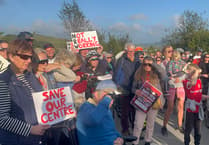Changes in guidance for planning applications in flood risk areas could give greater flexibility for developments in Aberystwyth following constant frustration after a series of ventures were turned down in the town centre following Natural Resources Wales objections.
Natural Resources Wales (NRW) maintains the Flood Map for Planning which supports national planning policy TAN15: Development, flooding and coastal erosion.
The map shows how climate change will affect the extent of flood risk across Wales over the next century and indicates the potential extent of flooding assuming no defences are in place.
It is used to determine whether planning applications can go ahead in specific flooding zones, with three such zones covering large parts of Aberystwyth.
As well as the long-running saga of attempting to bring Aldi to an unused site on Park Avenue in Aberystwyth - which was ultimately quashed by the Welsh Government over flooding concerns despite being backed by Ceredigion councillors - smaller applications such as plans to turn a former shop on Great Darkgate Street into a café have also been turned down after NRW flood risk objections despite being in the middle of town.
Plans for a major redevelopment of Aberystwyth Town Football Club’s home ground, however, were given the go-ahead despite NRW’s warnings of a “significant flood risk”.
Plans to extend Maesyrafon car park – which also lies in the flood zone where Aldi wanted to build – was also given the go-ahead despite NRW objections.
NRW says the Flood Map for Planning “represents the best available information on flood risk and is the framework for assessing risks to and from new development.”
The majority of Aberystwyth seafront is a Flood Zone 3 area – designated as having more than 0.5 per cent (1 in 200) chance of flooding from the sea in a given year, while areas along the river Rheidol are also a Flood Zone 3 area with more than one per cent (1 in 100) chance of flooding from rivers in a given year.
In updated guidance in March, Aberystwyth now has TAN15 Defended Zones Areas covering areas of the town centre and along the river Rheidol where “flood risk management infrastructure provides a minimum standard of protection against flooding from rivers of 1:100 and from the sea of 1:200.
Those zones were previously flood zone 2 or 3 areas, putting a higher burden on evidence of flood mitigation, with the ability for the Welsh Government to ‘call-in’ such applications if approved despite NRW advice, as was the case with Aldi.
The TAN15 Defended Zones “act as a screening tool to enable planning authorities to consider development in areas which may otherwise be mapped as Flood Zone 3 or 2 and could limit development opportunities.”
The new zones will now give Ceredigion more flexibility to allow development in the centre of town and along the river Rheidol towards Llanbadarn.
NRW objected to the changes, saying that sea and river defences “do not eliminate risk entirely”, but added it would support the Welsh Government on the updated guidance.
All new full planning applications submitted from 31 March will now need to refer to the new TAN15 document, including the new Defended Zones.
The full guidance says that it is “important that risks of flooding are given full consideration by the planning system.”
NRW did not respond to questions for this article, but in its flood management plans said: “We are continuing to support the Welsh Government as they revise planning policy TAN15: Development, Flooding and Coastal Erosion (TAN15).
“Further changes were proposed to TAN15 as part of a public consultation held in 2023.
“The proposed changes have sought to introduce an increased element of flexibility to facilitate regeneration and redevelopment where the risk of flooding is reduced due to the presence of risk management authority managed and maintained flood defences.
“Areas benefitting from these defences are mapped in the Flood Map for Planning (FMfP) as TAN15 Defended Zones.
“We have raised concerns with the proposed policy changes, as whilst flood defences reduce the probability of flooding, they do not eliminate the risk entirely.
“Defences can be overtopped or fail and the consequences of such an event can be significant so we have strongly recommended that revisions to TAN15 seek to ensure future development is resilient to increasing flood risks and coastal erosion in the context of a changing climate.”
A Ceredigion County Council spokesperson told the Cambrian News: “Objections from statutory consultees such as NRW on technical matters carry significant weight in decision-making, they are one of a number of factors that determine the outcome of an application.
“Ceredigion County Council welcomes the publication of TAN 15 and acknowledges that whilst this national guidance adds greater evidentiary burdens on applications, it offers pathways for re-development of previously used land in sustainable locations where that evidence is presented.”
While the Defended Zones will now have added flexibility for potential development and re-development, Aberystwyth seafront will likely remain off limits as it sits in a Flood Zone 3.
The TAN15 guidance says that no new highly vulnerable development will be permitted in Zone 3, regardless of the conclusions of a Flood Consequence Assessment, with the exception of proposals “essential to the Development Plan Strategy.”
Redeveloping existing, previously used land in flood-prone areas might be more acceptable under specific conditions, likely involving robust flood resilience measures.
It is not yet known how a potential multi-million pound sea defence scheme for Aberystwyth would affect the zones on NRW’s flooding map, nor whether it would make schemes easier to approve for frustrated businesses and developers.
An outline business case for that scheme was submitted to the Welsh Government last November, with hopes of starting work in 2026 after a full business case was developed and submitted.
NRW’s annual report 2023/24 said its aim is to “provide effective advice to influence and control development in flood risk areas, preventing more people and properties becoming exposed to increased flood risk.”
“Over the past year, our advice has helped to prevent inappropriate development being approved in locations where the risk of flooding would be difficult to manage,” the NRW report says.
“Where development has been permitted despite the flood risks, we have provided advice on flood resistance and resilience measures that could be incorporated to help reduce the risk both now and in the future.”
During 2023/24, NRW received and responded to more than 2,300 planning consultations where flood risk was identified by the Local Planning Authority as a potential constraint.
In a report, Natural Resources Wales said that Aberystwyth is in the top five communities in mid Wales “that are projected to experience the biggest change in danger from the risk of flooding” from both rivers and seas by 2120.
The original TAN15 guidance was first issued in July 2004, and has been in continual use and updated regularly.
The requirements have become more stringent in recent years over climate change fears and the more regular occurrence of storms and subsequent flooding along rivers and seafronts.
The new TAN guidance came into immediate effect on 31 March and emphasises a “risk-based approach”, utilising the Flood Map for Planning to balance the likelihood of flooding events against the vulnerability of developments.





Comments
This article has no comments yet. Be the first to leave a comment.